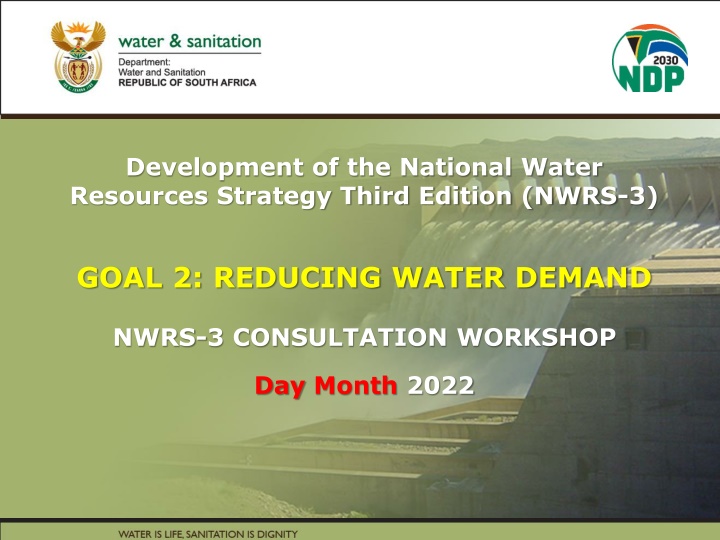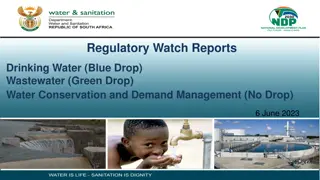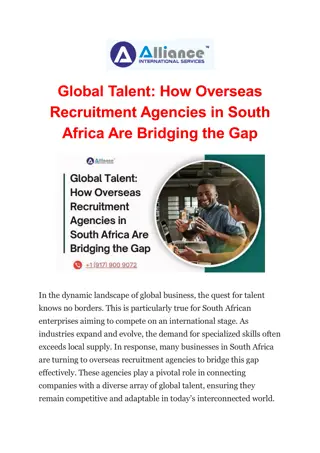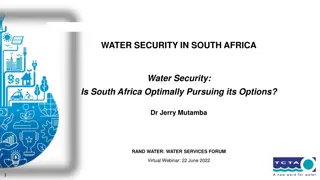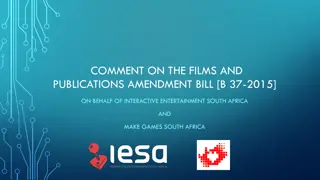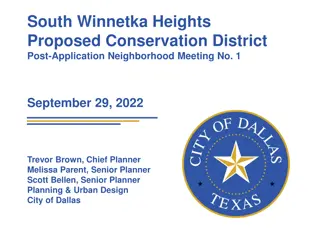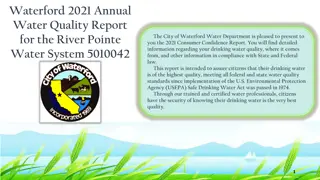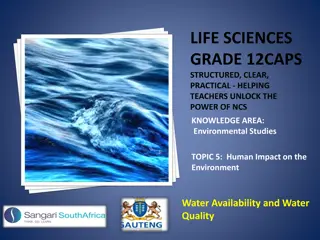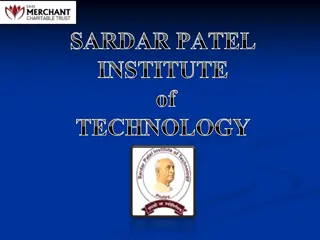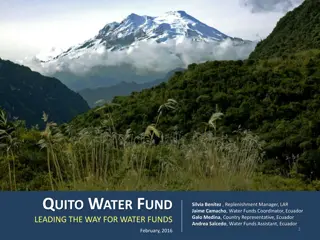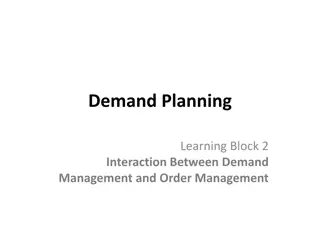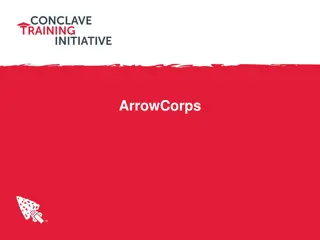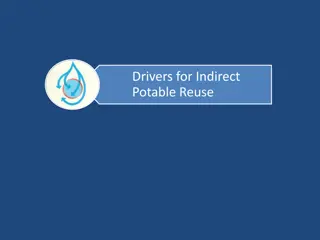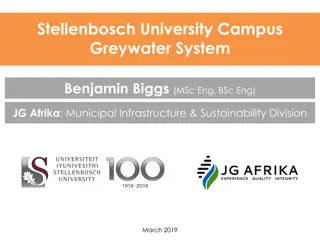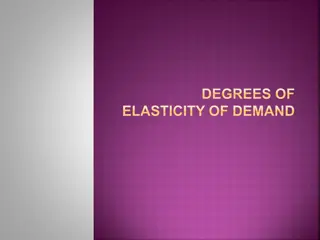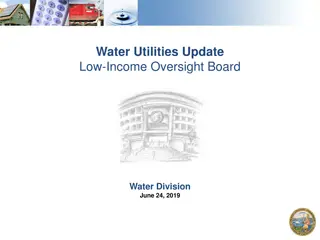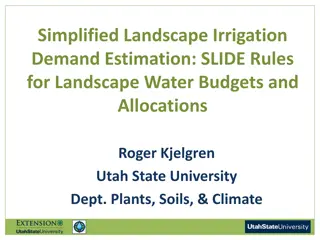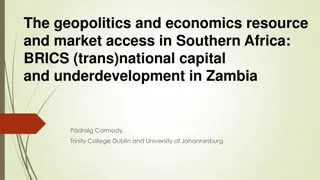Enhancing Water Conservation and Demand Management in South Africa
The National Water Resources Strategy Third Edition (NWRS-3) focuses on reducing water demand in South Africa by implementing effective water conservation and demand management measures across various sectors. Challenges include inadequate planning, lack of funding, and weak enforcement tools. Sectors like agriculture, forestry, water and sanitation services, industry, mining, and power generation face specific issues that hinder efficient water use. The need for social awareness campaigns and advocacy programs is also highlighted to address high water consumption levels in a water-scarce country.
Download Presentation

Please find below an Image/Link to download the presentation.
The content on the website is provided AS IS for your information and personal use only. It may not be sold, licensed, or shared on other websites without obtaining consent from the author.If you encounter any issues during the download, it is possible that the publisher has removed the file from their server.
You are allowed to download the files provided on this website for personal or commercial use, subject to the condition that they are used lawfully. All files are the property of their respective owners.
The content on the website is provided AS IS for your information and personal use only. It may not be sold, licensed, or shared on other websites without obtaining consent from the author.
E N D
Presentation Transcript
Development of the National Water Resources Strategy Third Edition (NWRS-3) GOAL 2: REDUCING WATER DEMAND NWRS-3 CONSULTATION WORKSHOP Day Month 2022
NWRS-3 CH4: Reducing Water Demand The aim of this chapter is: To ensure efficient use of water by all sectors through the implementation of appropriate water conservation and water demand management measures to meet the social and economic needs of South Africa both now and in the future. This chapter consists of the following4 sections: Context and Current Challenges Guiding Principles Baseline and Status Quo Strategic Objectives and Strategic Actions for implementation (see next slides) 2
NWRS-3 CH4: Context & Current Challenges Water Conservation /Water Demand Management is still not treated as a priority hence there is still lack of proper planning, implementation, reporting and regulation. The following challenges are experienced per sector: Agriculture No sufficient critical measurement at critical control points in the irrigation schemes. No real time operation and management of water conveyance system which causes high water losses and return flows (WAS). Old and deteriorating infrastructure leading to high water losses and wastages due to lack of adequate operation and maintenance No monitoring of soil moisture content, scheduling of irrigation and optimum operation of irrigation systems. 3
NWRS-3 CH4: Context & Current Challenges Forestry The ongoing spread of invasive alien plant species also reduces water availability in the country. Water and Sanitation Services Institutions and Local Government Lack of adequate funding. Lack of skilled personnel and capacity. Non-institutional prioritization of WC/WDM. Lack of adequate planning which leads into none implementation of WC/WDM Plans. Lack of operation and maintenance of water distribution systems. Lack of sound water accounting, meter management programmes and effective billing measures for all consumers. Lack of capacity to monitor, enforce compliance with WC/WDM Regulation 509. 4
NWRS-3 CH4: Context & Current Challenges Industry, Mining, and Power Generation Limited implementation of meaningful WC/WDM initiatives by the sector. No agreed key performance standard for the industries. No reporting and monitoring system in place. Weak WC/WDM enforcement tools. Need to strengthen existing partnership with various sector partners. Social Awareness and Advocacy Programmes Awareness campaigns are more reactive rather than pro-active. The water sector does not prioritise social advocacy initiatives in their WC/WDM planning in terms of funding and human capacity. Currently the focus is on Local Government sector/water users. Customer Service Centres at Local Government level are inadequate to deal with customer queries and complaints. Lack of integration of social advocacy initiatives within the sector. South Africa has the World highest per capita consumption while we are a water scarce country. 5
NWRS-3 CH4: Guiding Principles The National Water Conservation and Water Demand Management (NWC/WDM) strategy was developed using the following three fundamental principles: Water Institutions should endeavour to supply water in an efficient and effective manner by minimising water losses and promoting WC/WDM to their consumers. Consumers should endeavour to use water efficiently. Water Conservation /Water Demand Management should be considered as part of the planning processes for water resources, water supply (to Agriculture, Domestic, Industry, Mines and Power) and water and sanitation services. 6
NWRS-3 CH4: Baseline and Status Quo Below is the baseline and status quo per sector: Agriculture Sector The irrigation sector is by far the largest water user in South Africa. The Department, through the Strategic Water Partnership Network (SWPN) has implemented the Water Administration System (WAS) Release Module at a number of irrigation schemes i.e. Hartbeespoort IB, Sand-Vet WUA, Orange-Riet WUA, Vaalharts WUA, Impala WUA, LORWUA and Loskop IB. With the WAS Release Module, we are able to release the correct amount of water from a dam (source) according to applications (demand). Irrigation schemes are submitting Water Use Efficiency Accounting Reports on a monthly basis reporting on their water use efficiency. Currently reports are received from 75% (59 of 78) of the big irrigation schemes. The average water loss of the applicable schemes is about 30%. It was determined that the seepage and evaporation loss in concrete canals, which is unavoidable, is about 12% of the total loss. 7
NWRS-3 CH4: Baseline and Status Quo Water and sanitation services Institutions and Local Government Sector The current status of municipal performance regarding WC/WDM is a concern taking considerations of the water security risk in the country The municipalities in the 8 large Water Supply System are situated in areas of high economic significance and should increase their efforts to achieve the targets set under the various water reconciliation strategies to ensure water security. 8 large water supply systems include, the Integrated Vaal River WSS, Crocodile West River WSS, Kwa-Zulu Natal Coastal Metropolitan WSS, Western Cape WSS, Algoa WSS, Amatole WSS, Greater Bloemfontein WSS and Olifants River WSS. The DWS monitor and analyse the progress made with the implementation of WC/WDM and targets set during the development of Reconciliation strategies, at municipal level, within the eight large water supply systems (WSS). The results for the target versus actual savings achieved for the 8 large water supply indicate a total of 12.7% achieved savings by June 2021 compared with a target of 12.0%, The Western Cape WSS, Greater Bloemfontein WSS, Algoa WSS, Amatole WSS and Olifants River have reached their targets, (low confidence in some of the systems). The remaining three ( Intergrated Vaal River, Kwa-Zulu Natal Coastal Metropolitan and Crocodile West River) WSS are generally following the high population without WC/WDM demand projections (DWS, 2022) The bulk of the savings were achieved in the Western Cape WSS. If the WCWSS is omitted from the calculation, then no savings were achieved by June 2021 8
NWRS-3 CH4: Baseline and Status Quo Water and sanitation services Institutions and Local Government Sector continued: The national International Water Association (IWA) water balance for water losses and non-revenue water indicates that both items are growing at a higher rate in spite of WC/WDM work and projects been implemented. In the year 2017, NRW was recorded as 41% (DWS, 2017a) but it has since grown to 45% in 2021 (DWS, 2022). This means stakeholders have to intensify implementation of WC/WDM measures to ensure growth of both variables is contained and targets as set out in the reconciliation strategies are achieved. The Department and the Water Resource Group launched a partnership with private partners at the World Economic Forum in 2011; this partnership is called Strategic Water Partners Network-SA (SWPN-SA) One of the first projects conceptualised under this partnership, was the No Drop Programme. The No Drop Programme is an incentive based regulatory programme aimed at assessing and improving the municipal water use efficiency, water losses and non-revenue water. The No Drop Programme is based on assessments against specific criteria to evaluate a municipality s performance against legal and international best practice requirements (No Drop Strategy, 2015). 9
NWRS-3 CH4: Baseline and Status Quo Water and sanitation services Institutions and Local Government Sector continued: First Order No Drop Assessment Results The results are based on the findings of a No Drop assessment which formed part (3%) of the 2014 Blue Water and sanitation services Audit as Criteria 6. The No Drop component focused on 3 KPAs namely: 1) water balance (30%); 2) strategy, planning and implementation (30%), and 3) performance and compliance (40%). All the 152 WSAs (949 water supply systems) participated in the No Drop assessment. In total: The national average No Drop score of 56.5% was achieved, which is considered average performance. The score is influenced by the good scores achieved (> 50 %) by Gauteng, KwaZulu-Natal, Western Cape, Eastern Cape, and Free State Provinces. The results shows that 51% of 152 WSAs have proper WC/WDM plans and strategies in place and are busy with some form of implementation in the field. A total of 38-40% of 152 WSAs have proper or partial water balances in place, which is a baseline requirement for planning and project scoping. The current status makes a strong case to focus on improvement in the quality of planning and the intensity and acceleration of implementing the No Drop Programme going forward. 10
NWRS-3 CH4: Baseline and Status Quo Industries, Mining and Power Generation Sector (IMP) Manufacturing Industries Manufacturing Sector is the pillar sector required to drive economic growth and social development of the country. The sector is rightfully earmarked for future growth in the water demand and need for WC/WDM in the sector cannot be over emphasized. The food and beverage sectors are highly dependent on water to produce their products. The Department through the SA/Danish SSC and other stakeholders (WRC , NCPC etc) is currently developing tools which will ensure efficient use of water in the sector. These include the following: Water meetening and monitoring guideline Water Use Efficiency Benchmarks, processing, etc KPIs for the Agro- 11
NWRS-3 CH4: Baseline and Status Quo Mining Sector The water allocation to mining industry currently represents about 2.5 % of total water allocation in South Africa. Major challenge is the potential impact on the environment and water pollution The efficiency of water usage by different mining sub-sectors has not yet been systematically monitored and determined. DWS through the collaboration with Mineral Council of South Africa has developed the following Water Use Efficiency tools for the Mining Sector: -Guideline for the development and implementation of water conservation / water demand management plans for the mining sector -Benchmarks for Water Conservation / Water Demand Management in the Mining Sector: Key Indicators and Commodity-based Water Use Benchmarks (coal, gold, platinum and other ). -Standardised Water Accounting Framework to support the establishment of an on-line WC/WDM reporting system that would be developed by DWS. A Standardised Water Accounting Framework (SWAF) was developed to ensure uniform and streamlined reporting on water use data and/or water balances by the mines. The Mineral Council SA has further developed a spreadsheet-based WUE Self-Assessment Reporting Tool (W-SART) to enable the mines to enter their water-balance data in a uniform format and, to also do computations for 5 year Site-Specific Targets which will inform the mine s WC/WDM Plans The Department will be Extending the MoU with the Mineral Council for further collaboration on Capacity Building and training as well as the unbundling of the Other category to have benchmark ranges for commodities like chrome ore, manganese ore, diamond etc. 12
NWRS-3 CH4: Baseline and Status Quo Power Generation Sector Power Generation The energy sector is only using 2% of water, contributes about 15% to the GDP of South Africa The energy sector, including Eskom, is highly dependent on reliable supply of water for the generation of electricity (steam generation and cooling processes), Sophisticated network of water transfer and storage schemes have been developed specifically to support this sector and ensure high levels of reliability. At present Eskom s coal based power plant fleet consists of 10 base load power plants (used during normal demand) and 3 return to service (RTS) power plants (used during peak demand). These power plants have diverse technical parameters and use a combination of cooling technologies which is bound to provide different water usage profiles. Eskom employs three types of cooling systems at it s power plants. The most common and older type is wet cooling, but there are also direct and indirect dry cooling systems Within the context of the current Integrated Resources Plan, South Africa s energy mix is bound to change in order to provide sufficient energy security. The department is working together with Eskom to ensure that all power stations comply with their general target (that Eskom has set itself) of 1.39 l/kWhSO (Liters/ per sent out (kilowatt hour sent out) The Energy sector has introduced a new technology in coal power generating stations which is called FLUE GAS DESULFURIZATION (FGD). This technology removes sulphur dioxide from exhaust flue gases of the fossil fuel power plants and the emissions of other sulphur oxide emitting processes. The main disadvantage of this technology is that it requires volumes of water to clear emissions. 13
NWRS-3 CH4: Baseline and Status Quo WC/WDM Social Awareness and Advocacy Programmes Evidence has shown that most technical interventions without adequate social engagement and education of communities often lead to failures of good technical interventions. The social pillar of WC/WDM is thus driven mainly to ensure community buy-in and support of technical programmes aimed at reducing water losses and wastages within communities. Increased use of social media campaigns should be considered and used in future. The department together with municipalities also conduct door to door campaigns where they distribute water use efficiency promotional material to community members and do live demonstration on how to fix leaking taps and toilets The Department also runs schools' competitions to involve learners in solving water issues, especially within the water use efficiency spectrum. The school's project is called the South African Youth Water Prize, which is a science & technology-based project. The competition begins at provincial level and proceeds to the national level. The national winner represents South Africa in the Stockholm Junior Water Prize (SJWP) in Stockholm, Sweden to compete with learners from 30 countries annually. Workshops are hosted with the irrigation schemes on water use efficiency and WC/WDM to ensure that the agricultural sector implements WC/WDM measures. 14
CH4 Strategic Objective 1: To ensure that all sectors use water efficiently and effectively to enhance existing WC/WDM programmes across all sectors. In order to achieve the above strategic objective the following strategic actions must be undertaken: Obtain and monitor WC/WDM plans from all water management and water and sanitation services institutions. Promote appropriate measures to influence the reduction in water wastage and ensure compulsory metering and billing. Ensure that the WUA and end users understand the need to modernise their water conveyance systems and irrigation equipment. Drive the reduction of physical leakage as part of the WC/WDM programmes through improved regulation and compliance. Encourage water management and services institutions to use the latest technologies in water release and distribution systems. Encourage all WSAs to submit monthly water balances so as to assist in monitoring the state of non-revenue water. 15
CH4 Strategic Objective 2: To raise the importance and the need for a change of attitude and behaviour in terms of how water is treated and conserved by all South Africans through education and awareness programmes. In order to achieve the above strategic objective the following strategic actions must be undertaken: Promote the efficient use of water amongst consumers and customers. Promote the use of water saving technologies by consumers and customers. Co-ordinate the implementation of a generic water education and awareness campaign. To ensure that water waste preventative maintenance programmes are put in place for users and consumers. Ensure that the concepts of environmental awareness and protection are promoted and accepted by all stakeholders. Encourage water users and WSAs to participate in the planning of water resources within regions. 16
CH4 Strategic Objective 3: To ensure all water use sectors set water use efficiency improvement targets and implement programmatic WC/WDM projects to achieve these set targets. In order to achieve the above strategic objective the following strategic actions must be undertaken: Reduce Non Revenue Water (NRW) and water losses in all municipalities. Set cap on municipal water use with reducing targets over time. Reduce the water demands and water losses at all major irrigation and agricultural schemes by 2030, without affecting production. Reduce water demand and increase water efficiencies of industrial users. Ensure adequate information to support implementation of WC/WDM measures and decision-making. Ensure the implementation of WC/WDM best practices in new developments. To ensure that water waste preventative maintenance programmes are put in place for water management and water and sanitation services institutions. Carry out ongoing water audit and water balance. Obtain sector reports on the achievement of set targets and monitor progress against meeting these targets. Adopt integrated planning principles. Ensure that sufficient WC/WDM measures have been implemented before new infrastructure development is considered. 17
CH4 Strategic Objective 4: To align the water use authorisation process with WC/WDM priorities and encourage interventions to improve water use efficiency. In order to achieve the above strategic objective the following strategic actions must be undertaken: Align the water use license authorisation process with WC/WDM priorities. Ensure that water allocations promote equitable and optimal utilisation of water. Enforce compliance with the conditions of authorization of water use license. 18
CH4 Strategic Objective 5: To strengthen capacity within the DWS and the water sector as a whole to implement WC/WDM programmes through institutional development, training and capacity building initiatives. . In order to achieve the above strategic objective, the following strategic actions must be undertaken: Develop implementation of WC/WDM by all water sector institutions. Provide oversight and ensure that effective WC/WDM measures are implemented across all sectors. Ensure adequate institutional and financial capacity for WC/WDM. Monitor, regulate and establish adequate governance to ensure the implementation of WC/WDM. Co-ordinate and co-operate with other government departments to facilitate the implementation of WC/WDM. guidelines, standards and tools to support the 19
NWRS-3 Goal 2 Discussion and Inputs Chapters 4 20
